|
The Van Campen Barn,
the
Wagon Shop,
and the Carriage Shed |
|
Pictures of the Van Campen barn as well as the wagon shop and
new carriage shed. The first two structures were moved to the village
by disassembling them and reerecting them on a foundation which was
built in Millbrook specifically for the buildings. The barn was just
south of the school and cemetary, and was rapidly losing its
structural validity. One corner post was badly rotted, and most of
the posts sat at or below ground level. Volunteers successfully took
down the barn, labeled the pieces, fixed or replaced the damaged
timbers, and had a barn raising to reerect the building in the
village. Finally, new rafters were constructed, and a cedar shake
roof was put on by our volunteers. The wagon shop was found roughly 3
miles south of Millbrook in the Recreation Area. It was originally a
bank barn with a full foundation, a first story, and an upper story
with a knee wall. Most of the timbers were poplar or pine, and the
entire building was in great shape. We decided that this building
would be great for a wagon shop, since several of our members were
interested in learning the wheelwright trade. Again, volunteers
gathered together for a raising and assembled the building. |
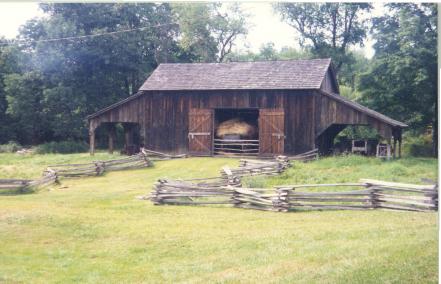
You'd think that this barn had been standing in one place for 100
years, but it's actually had to walk up the road about 1/2 mile from
its original site (it did have help) in 1985. The two side sheds were
added within a year of the main building's erection. In the center of
the building, you can also see a Conestoga style wagon (in excellent
condition). During some years since its erection, the barn has had
occupants of the bovine, goat and donkey type. Sadly, since we no
longer have full time residents in the village, its very hard to keep
the animals fed and comfortably housed.
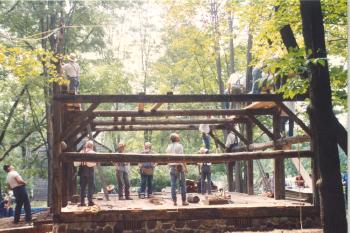
The northern side of the wagon shed during the day that the structure
was raised in Millbrook. The building consists of four bents that are
tied together via cross pieces. The building was assembled one bent
at a time starting from the north end and moving to the south. Bents
were erected with the aid of "gin poles", which are nothing
more than a temporary crane of two tall maple poles placed on either
side of the building. A block and tackle was place at the top of each
of these poles, and a rope was tied to the top of each bent. Muscle
was applied, and the combination lifted each bent.
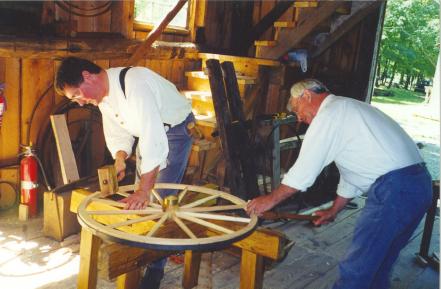
The interior of the wagonshop during a recent wheelwright workshop.
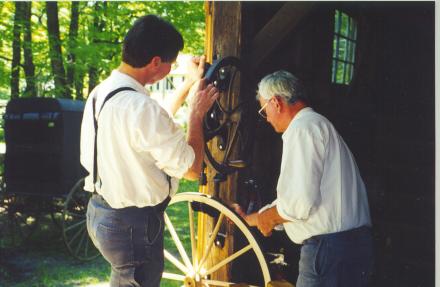
Securing he rim to the
wheel inside the wagon shop. The hand-powered drill press is a
donated piece of equipment, and works as well as it looks. In the
background is one of Millbrook's covered buggies.
Now, as usual, if you ever build something to store things in, you
know what's bound to happen. It's just like a closet. If you build
it, someone will find a way to fill it up to the point where you can
no longer use it. In the case of the wheelwright's shop, it became so
full of carriages, buggies, carts, and new projects, that it took
half the day to take the wagons, carts, and buggies out before you
could get to work! So, in 2002, a fairly simple carriage shed was
erected to allow visitors to see and store most of our assets under
roof. Pictures follow....
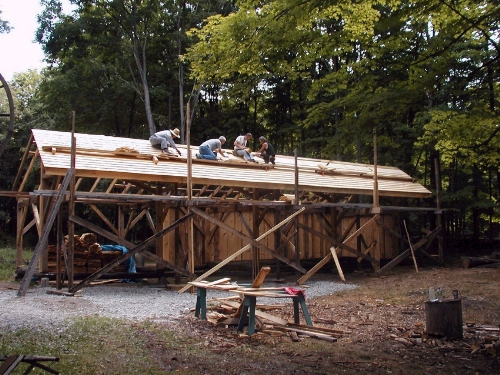
As you can see, it's
similar to today's pole-barn, but the beams and mortised and tenoned,
and held together with wooden pegs. The crews putting on cedar shakes....
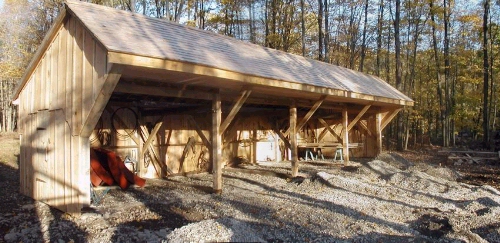
Leaning toward fall now,
The front doors aren't on yet, but you can see how much room is
available for carriages.
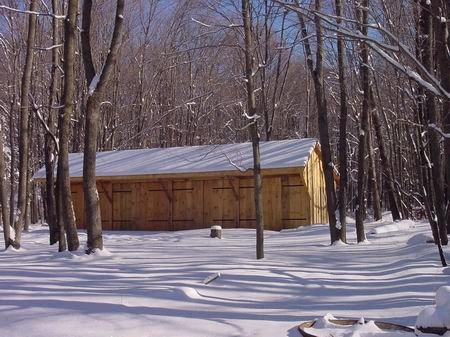
Winter and the front
doors are firmly in place with vehicles shut in inside impervious to
the elements.







